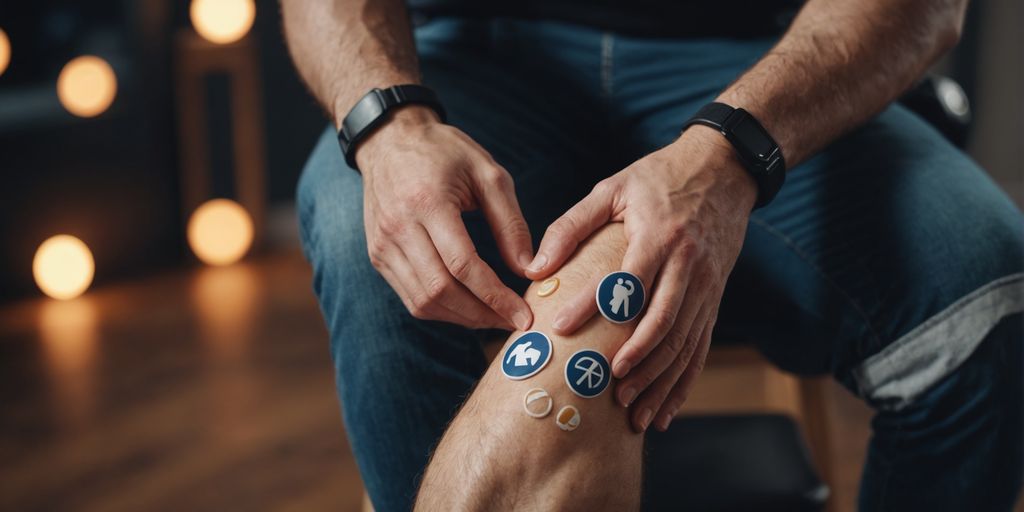Joint pain can become a common issue as we age, especially after 40. However, experiencing joint pain doesn’t have to be a life sentence. In this article, 5 Effective Strategies for Managing Joint Pain After 40, we will discuss several strategies you can adopt to manage and even reduce joint pain, helping you stay active and pain-free.
Key Takeaways
- Physical therapy can help improve joint function and reduce pain.
- An anti-inflammatory diet can decrease joint inflammation and pain.
- Regular exercise, especially low-impact activities, can strengthen muscles around the joints.
Joint Pain : 5 Effective Strategies for Managing It After 40
Discover practical and effective solutions for tackling Joint Pain as you age. In this guide, we outline five key strategies designed to help you manage discomfort, improve mobility, and maintain an active lifestyle after 40. Learn how to take control of your joint health and enhance your overall well-being.
1. Physical Therapy

Physical therapy is a fantastic way to manage joint pain, especially as we age. By staying active with appropriate exercises, we can keep our joints flexible and strong. A physical therapist can guide us through specific exercises tailored to our needs, helping to reduce pain and improve mobility.
Benefits of Physical Therapy
- Reduces Pain: Targeted exercises can help alleviate pain in affected joints.
- Improves Mobility: Regular movement helps maintain flexibility and range of motion.
- Strengthens Muscles: Strong muscles support and protect our joints.
Types of Exercises
- Stretching: Helps maintain flexibility and prevent stiffness.
- Strength Training: Builds muscle around the joints, providing better support.
- Low-Impact Aerobics: Activities like swimming or cycling are gentle on the joints but keep us active.
Remember, nurturing your knees as you age is crucial. Physiotherapy treatments and exercises are highly effective in managing knee pain caused by osteoarthritis. By staying active with appropriate exercises, we can significantly improve our quality of life.
Tips for Success
- Consistency is Key: Regular sessions yield the best results.
- Listen to Your Body: Don’t push through pain; adjust exercises as needed.
- Stay Positive: Progress might be slow, but every bit helps!
2. Anti-Inflammatory Diet
Switching to an anti-inflammatory diet can be a game-changer for managing joint pain. By reducing inflammation, we can help ease the discomfort in our joints and improve our overall health.
Foods to Include
- Omega-3 Fatty Acids: Found in nuts, fish, and seeds, these can help reduce inflammation.
- Fruits and Vegetables: Bell peppers, citrus fruits, and leafy greens are packed with anti-inflammatory compounds.
- Turmeric: This spice contains curcuminoids, which have strong anti-inflammatory properties.
- Tea: Black, green, or white tea contains EGCG, a polyphenol with powerful antioxidant and anti-inflammatory effects.
Foods to Avoid
- Processed Sugars: Cookies, sodas, and even some salad dressings can increase inflammation.
- Alcohol: Excessive consumption can lead to more inflammation and joint pain.
- Gluten and Dairy: Some people find that avoiding these foods helps reduce their joint pain.
Staying hydrated is crucial. Water and tea can help keep our joints lubricated and reduce pain.
By making these dietary changes, we can take a big step towards reducing joint pain and improving our quality of life.
3. Regular Exercise

Alright, let’s talk about regular exercise. We all know it’s good for us, but did you know it can actually help manage joint pain? Yep, you heard that right! When we keep moving, we help our joints stay flexible and strong. Plus, it can reduce stiffness and pain.
Keep Moving
It might seem strange, but staying active is one of the best things we can do for our joints. When we move, we strengthen the muscles around our joints, which helps protect them. So, don’t just sit around! Get up and move.
Low-Impact Activities
Not all exercises are created equal. For joint pain, we want to focus on low-impact activities. These are easier on our joints and still give us a good workout. Some great options include:
- Swimming
- Cycling
- Walking
- Yoga
- Tai Chi
Stretching
Stretching is super important too. It helps keep our muscles flexible and reduces the risk of injury. Try to include some stretching exercises in your daily routine. Even a few minutes can make a big difference.
Remember, it’s all about finding the right balance. We want to stay active without overdoing it. Listen to your body and take it easy if you need to.
So, let’s get moving and take control of our joint pain!
4. Hot and Cold Therapy
Managing joint pain can be a real challenge, but hot and cold therapy is a simple and effective way to find relief. Let’s dive into how we can use this method to ease our discomfort.
How It Works
Hot and cold therapy works by using temperature extremes to help our joints. Heat can open up blood vessels, promoting blood flow and relaxing muscles. On the other hand, cold therapy tightens blood vessels, reducing inflammation and numbing pain.
When to Use Heat
Heat is best for chronic pain. It helps to relax stiff joints and muscles, making it easier to move. We can use a heating pad, hot water bottle, or even take a warm bath or shower.
When to Use Cold
Cold therapy is ideal for acute injuries. Applying a cold compress or ice pack for 15 to 20 minutes several times a day can reduce swelling and inflammation. After 20 minutes, it is recommended to remove the ice pack, place it back in the freezer, and apply again after 40 minutes to one hour.
Tips for Success
- Experiment: Some people with chronic pain might find more relief with cold, and vice versa. Try both to see what works best for you.
- Consistency: Regular use of hot and cold therapy can provide ongoing relief.
- Safety: Always use a barrier, like a cloth, between your skin and the heat or cold source to prevent burns or frostbite.
Finding the right balance between hot and cold therapy can make a big difference in managing our joint pain. Let’s give it a try and see how much better we can feel!
5. Joint Supplements
When it comes to managing joint pain, especially as we age, supplements can be a game-changer. They can help ease the discomfort in our painful knees, hips, and even wrists. Let’s dive into some of the most effective ones.
Fish Oil
Fish oil is packed with omega-3 fatty acids, which are known to reduce inflammation. This can be particularly helpful if you have arthritis in your hands or if your hips hurt. A typical dosage ranges from 250 to 500 milligrams per day, but always check the label and consult your doctor.
Curcumin
Curcumin, the active ingredient in turmeric, is another powerful anti-inflammatory. It’s great for reducing joint pain and stiffness. You can find it in capsule form or add turmeric to your meals.
Glucosamine and Chondroitin
These two supplements are often taken together and are known to support joint health. They can help with everything from elbow pain to a frozen shoulder. They work by maintaining the cartilage in your joints, making movement easier.
Quercetin
Quercetin is a flavonoid found in many fruits and vegetables. It’s known for its anti-inflammatory and antioxidant properties. This can be particularly beneficial if your wrists hurt or you have hip pain.
Flaxseed Oil
Flaxseed oil is another excellent source of omega-3 fatty acids. It’s a good alternative if you don’t like fish oil. It can help reduce inflammation and ease joint pain.
Taking the right supplements can make a world of difference in managing joint pain. Always consult with your healthcare provider before starting any new supplement regimen.
Joint supplements can be a game-changer for anyone dealing with joint pain or stiffness. They help support joint health and improve mobility. If you’re looking for a reliable solution, check out our range of joint supplements. We offer different packages to suit your needs, all backed by a 60-day money-back guarantee. Visit our website to learn more and find the perfect option for you.
Conclusion
Managing joint pain after 40 doesn’t have to be a daunting task. By incorporating these five strategies into your daily routine, you can take control of your joint health and improve your quality of life. Remember, staying active, eating well, getting enough sleep, managing stress, and seeking professional help when needed are all key components to keeping your joints healthy. Don’t let joint pain hold you back from enjoying life. With the right approach, you can continue to do the things you love and live a fulfilling, active life.
Frequently Asked Questions
What types of exercises are best for joint pain?
Low-impact exercises like swimming, cycling, and walking are great for joint pain. These activities help you stay active without putting too much stress on your joints.
Can diet really help with joint pain?
Yes, eating an anti-inflammatory diet can help reduce joint pain. Foods like fresh fruits, vegetables, and whole grains can lower inflammation and ease pain.
Are joint supplements effective?
Some people find relief using joint supplements like glucosamine and chondroitin. However, it’s best to talk to your doctor before starting any new supplement.




